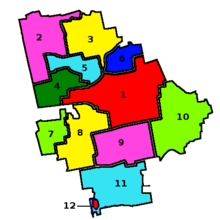Saporiske (Sofijiwka)
| Saporiske | ||
| Запорізьке | ||

|
|
|
| Basic data | ||
|---|---|---|
| Oblast : | Dnepropetrovsk Oblast | |
| Rajon : | Sofiyivka Raion | |
| Height : | 121 m | |
| Area : | 2.149 km² | |
| Residents : | 440 (2001) | |
| Population density : | 205 inhabitants per km² | |
| Postcodes : | 53140 | |
| Area code : | +380 5650 | |
| Geographic location : | 48 ° 8 ' N , 33 ° 56' E | |
| KOATUU : | 1225283501 | |
| Administrative structure : | 2 villages | |
| Mayor : | Lidija Mykolaiivna Demchenko | |
| Address: | вул. Постного 75 53 140 с. Запорізьке |
|
| Website : | official website | |
| Statistical information | ||
|
|
||
Saporiske (Ukrainian Запорізьке , Russian Запорожское / Zaporozhskoje ) is a village in Ukraine with about 400 inhabitants (as of 2015).

geography
The village is the administrative center of the district council of the same name in the north of Sofiyivka Raion in Dnepropetrovsk Oblast on the Kamyanka River . The village of Bratske ( Братське ) also belongs to the municipality .
history
In 1759 the place was established as a settlement for Cossacks . The town was founded in 1786 when Wassil Engelhardt received a plot of land along the river. At first 17 farmers lived there. The son of the village founder, General Wassil, inherited the property and built 20 farms and 2 mills. Later the place was renamed Engelhard-Wassilewka (Энгельгард-Василевка) or shortened Wassilewka . In 1875 a school was built from mud bricks, which was run by the church, and only in winter. In 1885 a wooden church was built where there is now a workshop. In 1886, 364 people lived in the village. In 1897 there were 1027 inhabitants in the village. In 1908, 1,399 people lived in the village.
Before the Russian Revolution of 1917 there were around 20 wealthy families who owned the land, the other residents did not own any land. In 1905 there was a riot against it, but it was suppressed. In 1918 the Soviet regime was introduced in the village. In the late 1920s began dekulakization of wealthy families. In the 1930s there were 2 peasant collectives.
In 1941 the village was occupied by the Wehrmacht . The Germans divided the 2 collectives into 10 families. Several boys and girls were brought to Germany as Eastern workers . In 1943 there was fighting for the reconquest, with Tele of the main street burned down. The school was turned into a hospital. On November 28, 1943, the village was liberated by Red Army infantrymen . The local war graves were reburied in a mass grave in front of the school in 1945. It contains the remains of hundreds of soldiers and one villager.
After the war, the 2 collectives were restored. In 1958 they were united. 1967 were u. a. a new club and a post office built. In 1964 the village was renamed to its current name as a reminiscence for the Zaporozhian Cossacks . In the 1980s, the water supply system was expanded considerably. In 1992 the first private homestead was established.


